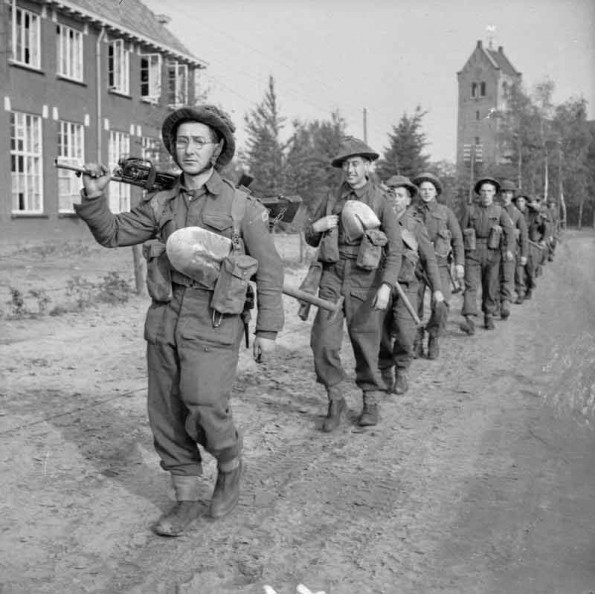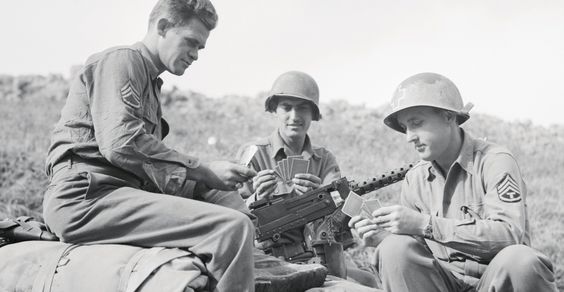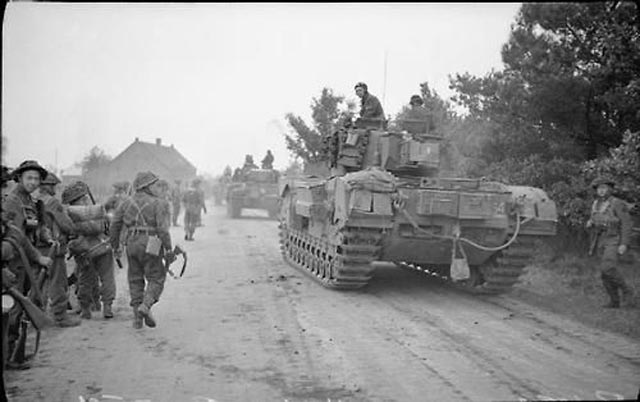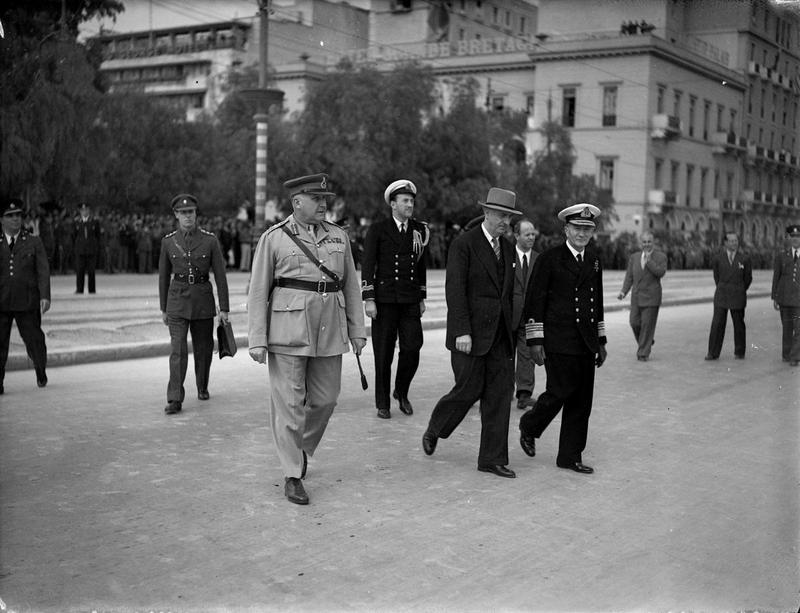Air Operations, CBI
BURMA- The 10th Air Force continues to mount an all-out effort in support of Allied ground offensives in northern and central Burma.
- 308th Heavy Bomb Group B-24s and 341st Medium Bomb Group B-25s attack shipping in the South China Sea.
- B-25s attack shipping along the Yellow River.
- B-25s and 14th Air Force fighters attack rail facilities at Hsuchang.
- Fighters attack Mengshu and nearby targets of opportunity, and targets of opportunity near Kweiping.
- 311th Fighter Group P-51s down 2 Ki-44 'Tojo' fighters near Wuchih at 1335 hours.
- 14th Air Force fighters attack Hongay while conducting an armed reconnaissance mission.
Air Operations, East Indies
V Fighter Command P-40s attack numerous targets of opportunity in the Molucca Islands.
[Air Operations, Europe
RAF BOMBER COMMANDDaylight Ops:
- 105 Lancasters of No. 3 Group carry out a G-H raid on Leverkusen, with the chemical works being the target of the intended bombing area. The raid appears to proceed well but cloud prevents any observation of the results.
- There are no losses.
- 1 Hudson is on a Resistance operation and there are 4 RCM sorties.
- There are no losses.
Minor Ops:
- 10 Lancasters of No. 1 Group lay mines off Heligoland, and there are 42 Mosquito patrols and 26 RCM sorties.
- 1 mine-laying Lancaster is lost.
GERMANY:
- 155 1st Bomb Division B-17s attack the city of Bielefeld (primary).
- 108 1st Bomb Division B-17s attack an industrial plant at Munster.
- 87 1st Bomb Division B-17s attack the city of Munster.
- 25 1st Bomb Division B-17s attack other targets of opportunity.
- 242 2nd Bomb Division B-24s attack the Mittelland Canal and an aqueduct at Minden.
- 65 2nd Bomb Division B-24s attack the synthetic-oil plant at Bottrop.
- 33 2nd Bomb Division B-24s attack the city of Munster.
- 155 3rd Bomb Division attack an industrial target at Hannover.
- 221 3rd Bomb Division attack the city of Hannover.
- 37 3rd Bomb Division attack other targets of opportunity.<
- 1 of 626 VIII Fighter Command escorts is lost
ETO:
- The 9th Bomb Division is grounded by bad weather, but 9th Air Force fighters attack tactical targets along and behind various fronts.
AUSTRIA:
- In the day's only offensive action in the MTO, 7 15th Air Forc B-17s attack marshalling yards at Innsbruck.
Air Operations, Japan
2 28th Composite Bomb Group B-25s attack Onnekotan Island.
[Air Operations, New Guinea
V Bomber Command B-25s and A-20s attack Urarom.
[Air Operations, Philippines
Beginning at 0830 hours, in the final encounter of the Battle of Leyte Gulf, US carrier strike groups from Task Group 38.1 and Task Group 38.2 attack the retiring Japanese Center Force in the Sibuyan Sea near Panay. 1 light cruiser and 1 destroyer are sunk and 1 heavy cruiser is damaged, but the rest of the Japanese surface force runs beyond range.
Beginning at 1000 hours, a total of 22 TBMs and 33 FMs and F6Fs from Task Unit 77.4.1 and Task Unit 77.4.2 attack a Japanese Navy transport force off western Leyte. 1 light cruiser, 1 destroyer, and 2 of 4 transports are sunk at a cost of 1 TBM and 1 FM, from which all 4 airmen are recovered. Escort-carrier aircraft also attack port facilties on Cebu.
Nearly 50 FEAF B-24s arrayed in several formations attack powerful elements of the Japanese Navy’s Combined Fleet—including aircraft carriers and battleships—west of Panay. A Japanese light cruiser, crippled in earlier action, is mortally damaged in separate attacks by 21 5th Heavy Bomb Group B-24s, and 22 V Bomber Command B-24s. 27 307th Heavy Bomb Group B-24s attack and lightly damage 2 battleships, losing 3 aircraft to anti-aircraft fire. 8 5th Heavy Bomb Group B-24s attack and near-miss a Japanese light cruiser.
In all, the Japanese Navy’s Combined Fleet has lost 3 battleships, 1 fleet carrier, 3 light carriers, 6 heavy cruisers, 4 light cruisers, 9 destroyers, and 2 transports. US Navy losses in the multi-faceted battle are the light carrier USS Princeton, the escort carriers USS Gambier Bay and USS St. Lo, 2 destroyers, and 1 destroyer-escort.
V Bomber Command B-25s attack Iligan, Luzon. V Fighter Command P-38s attack motor vehicles around Davao, Mindanao. 29 escort-carrier TBMs and 62 fighter-bombers support thye US 6th Army ground forces in Leyte.
At about 1240 hours, the escort carrier USS Suwanee is severely damaged by a kamikaze and a bomb dropped by another airplane. More than 100 crewmen and airmen are killed and more than 170 are injured. In all during the three-day Battle of Leyte Gulf, Task Group 77.4 escort carriers lose 1,118 crewmen and airmen killed and 913 wounded.
More than 90 US carrier aircraft temporarily based at Tacloban and Dulag airfields on Leyte are able to mount combat missions from these fields after fuel and munitions are transported to the bases by landing barge.
US carrier-based fighters (and 2 light-bomber crews) down a total of 46 Japanese bombers and fighters over the central Philippines between 0715 and 1825 hours.
[Battle of Leyte Gulf
During this day American air attacks sink 3 more cruisers from the various retiring Japanese squadrons. Overall the Leyte Gulf battle has been a shattering defeat for the Japanese as well as, in part, a tale of missed opportunities. The Japanese have lost 3 battleships: the giant Musashi, of 72,800 tons fully laden, the Fuso and the Yamashiro; 4 aircraft carriers, the heavy carrier Zuikaku and the light carriers Chitose, Chiyoda and Zuiho; 6 heavy cruisers, Maya, Atago, Chikuma, Chokai, Suzuya and Mogimi; 4 light cruisers, Tama, Abukuma, Noshiro and Kinu; 10 destroyers, Asagumo, Shiranuhi, Wakaba, Michishio, Yamagumo, Akitsuki, Hatzusuki, Hayashomo, Nowaki and Uranami, as well as minor vessels.
The Americans have lost the light aircraft carrier Princeton (CVL-23), the escort carriers St Lo (CVE-63) and Gambier Bay (CVE073), the destroyers Hoel (DD-533) and Johnston (DD-557) and the escort destroyers Eversole (DE-404) and Samuel B. Roberts (DE-412), plus 2 submarines, one of which sank as a result of a malfunction of its own torpedoes. Many other craft have been more or less seriously damaged, mostly by Japanese suicide pilots, among them 7 escort carriers, 1 light cruiser, 8 destroyers, 2 landing craft and 1 tanker.
After Leyte the Japanese have few of their purpose-built carriers remaining, but this loss is of less consequence that the serious damage done to their battleship and cruiser force because of the already existing shortage of trained pilots. In the action in the Surigao Strait is none of the former night-fighting expertise. Clearly, in the future, the operations of the Japanese Fleet will be even more circumscribed and their only hope now is in the new suicide attacks which have been very successful in their way so far.
[Britain, Home Front
Princess Beatrice, favorite daughter of Queen Victoria, dies at the age of 87. The death of the influential and popular ecclesiastic William Temple, Archbishop of Canterbury, is also reported. He was 63.
[Burma
The Chinese 22nd Div, advancing in the center of the north Burma front, reaches the airfield 25 miles southeast of Hopin formerly used by the Chindits and known by them as 'Broadway'. The division stays here for several days.
[Eastern Front
In Hungary the pincers of the 2nd and 4th Ukraine Fronts link up at Mukachevo in the southern Carpathian foothills near Uzhgorod. The Hungarian 1st Army and the German 1st Panzer Army withdraw in good order. This front is more or less stabilized along the Tisza River, with a Russian salient north of the river near Subotica along the Belgrade-Budapest railway.
SOUTHERN SECTORUzhgorod falls to the 18th Army. Elements of the 18th Army link up with the 40th Army at Mukhachevo but narrowly misses isolating the 8th Army and 1st Hungarian Army.
[Italy
There is patrol activity along the whole of the US 5th Army front. In the British 8th Army sector, the 10th Indian Div of V Corps strengthens its bridgehead over the Ronco River, but the swollen river holds up the operations of the 4th Div on its south bank, and incessant rain immobilizes the Canadian I Corps.
[Pacific
- The US submarine Drum (SS-228) sinks the Japanese transport Tatsora Maru and merchant passenger/cargo ship Taisho Maru (6886t) and cargo ship Taihaku Maru (6886t) north of Luzon.
- The US submarine Icefiah (SS-367) sinks the Japanese merchant cargo ship Taiyo Maru (4168t) west of Luzon, but is damaged by depth charges and is force to terminate her patrol.
- The US submarine Rock (SS-274) sinks the Japanese merchant tanker No.7 Takasago Maru (834t) near the Balabac Strait.
Palau Islands
On Peleliu the determined resistance of the Japanese in the Mount Umurbrogol pocket shows no signs of giving way, although the suicide garrison is already reduced to holding a few cave positions and the whole pocket measures little more than about 550 yeards from north to south and about 350-475 yards from east to west. Japanese resistance is favored by bad weather and difficult terrain.
[Philippines
In the northern sector, the Americans advance slowly from the north into Leyte Valley. In the central-southern sector they try to capture Catmon Hill just north of Dulag but the attacks are repulsed by the defenders who then withdraw much of their garrison from this excessively exposed area. Units of the US 7th Inf Div overcome obstinate Japanese resistance to reach the edge of Buri airfield. The Japanese garrison on the island receives about 2,000 reinforcements at their base at Ormoc.
[Western Front
The British 52nd Div lands on the south side of Beveland near Baarland and carries out a combined operation and succeeds in establishing a beachhead there against heavy German resistance. The Canadian forces are still fighting along the Beveland Isthmus.
In Braband, the 53rd Div of XII Corps, British 2nd Army, advances beyond s'Hertogenbosch.
To the south in the 7th Army sector the battle for St Dié continues as the US 3rd Div attacks in the teeth of deadly fire from the Germans.
[Images from October 26, 1944
|
|
|
|
|
|





